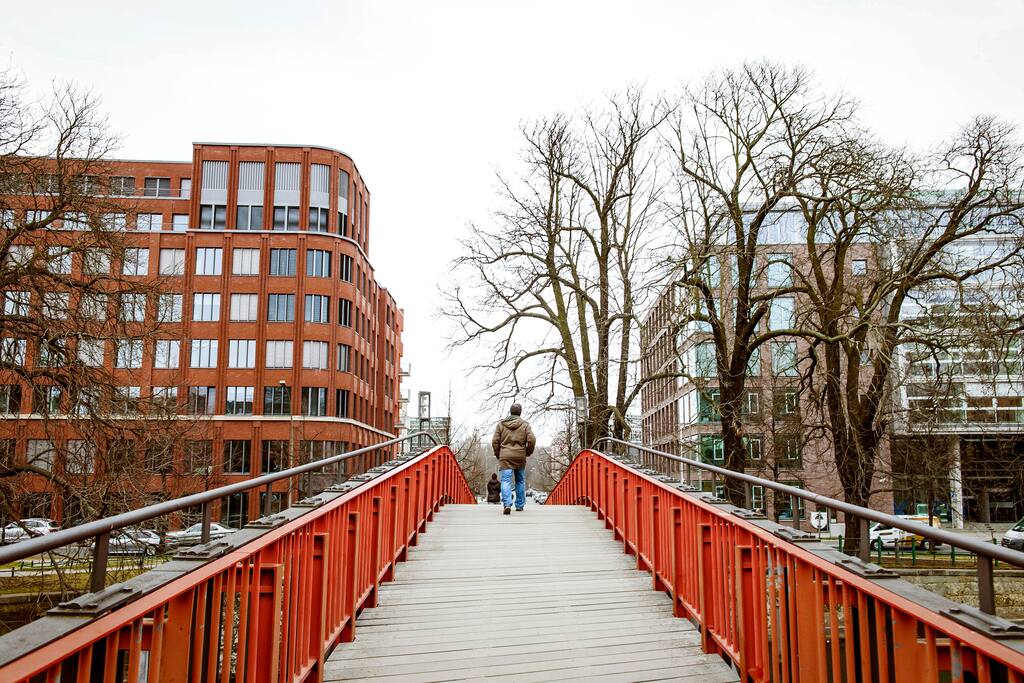Food Scene
If you want to enjoy your trip and to have the feeling you are in vacation, that its the right place for a cocktail 🍸 😉
21 Recomendado por los habitantes de la zona
Cocktailbar Zeitlos
100 FranklinstraßeIf you want to enjoy your trip and to have the feeling you are in vacation, that its the right place for a cocktail 🍸 😉
Opened in 1891, this restored market hall offers local food, crafts & art, plus activities & events.
123 Recomendado por los habitantes de la zona
Arminius Market Hall
2-4 ArminiusstraßeOpened in 1891, this restored market hall offers local food, crafts & art, plus activities & events.
Wald cafe
4 WaldstraßeSapori di Casa
61-62 Wilsnacker Str.Neighbourhoods
Moabit (German pronunciation: [moaˈbiːt]) is an inner city locality in the borough of Mitte, Berlin, Germany. As of 2016, around 77,000 people lived in Moabit. First inhabited in 1685 and incorporated into Berlin in 1861, the former industrial and working-class neighbourhood is fully surrounded by three watercourses which define its present-day border. Between 1945 and 1990, Moabit was part of the British sector of West Berlin that directly bordered East Berlin.
9 Recomendado por los habitantes de la zona
Moabit
Moabit (German pronunciation: [moaˈbiːt]) is an inner city locality in the borough of Mitte, Berlin, Germany. As of 2016, around 77,000 people lived in Moabit. First inhabited in 1685 and incorporated into Berlin in 1861, the former industrial and working-class neighbourhood is fully surrounded by three watercourses which define its present-day border. Between 1945 and 1990, Moabit was part of the British sector of West Berlin that directly bordered East Berlin.
Sightseeing
The Victory Column (German: Siegessäule (help·info), from Sieg ‘victory’ + Säule ‘column’) is a monument in Berlin, Germany. Designed by Heinrich Strack after 1864 to commemorate the Prussian victory in the Danish-Prussian War, by the time it was inaugurated on 2 September 1873, Prussia had also defeated Austria and its German allies in the Austro-Prussian War (1866) and France in the Franco-Prussian War (1870–71), giving the statue a new purpose. Different from the original plans, these later victories in the so-called unification wars inspired the addition of the bronze sculpture of Victoria, the Roman goddess of victory, 8.3 metres (27 ft) high and weighing 35 tonnes, designed by Friedrich Drake. Berliners have given the statue the nickname Goldelse, meaning something like "Golden Lizzy".[1]
296 Recomendado por los habitantes de la zona
Columna de la Victoria
1 Großer SternThe Victory Column (German: Siegessäule (help·info), from Sieg ‘victory’ + Säule ‘column’) is a monument in Berlin, Germany. Designed by Heinrich Strack after 1864 to commemorate the Prussian victory in the Danish-Prussian War, by the time it was inaugurated on 2 September 1873, Prussia had also defeated Austria and its German allies in the Austro-Prussian War (1866) and France in the Franco-Prussian War (1870–71), giving the statue a new purpose. Different from the original plans, these later victories in the so-called unification wars inspired the addition of the bronze sculpture of Victoria, the Roman goddess of victory, 8.3 metres (27 ft) high and weighing 35 tonnes, designed by Friedrich Drake. Berliners have given the statue the nickname Goldelse, meaning something like "Golden Lizzy".[1]
Charlottenburg (German: [ʃaʁˈlɔtn̩bʊʁk] (listen)) is an affluent locality of Berlin within the borough of Charlottenburg-Wilmersdorf. Established as a town in 1705 and named after late Sophia Charlotte of Hanover, Queen consort of Prussia, it is best known for Charlottenburg Palace, the largest surviving royal palace in Berlin, and the adjacent museums.
293 Recomendado por los habitantes de la zona
Palacio de Charlottenburg
10-22 Spandauer DammCharlottenburg (German: [ʃaʁˈlɔtn̩bʊʁk] (listen)) is an affluent locality of Berlin within the borough of Charlottenburg-Wilmersdorf. Established as a town in 1705 and named after late Sophia Charlotte of Hanover, Queen consort of Prussia, it is best known for Charlottenburg Palace, the largest surviving royal palace in Berlin, and the adjacent museums.
Moltke Bridge is a bridge over the Spree River in Berlin, Germany. Completed in 1891, it connects Alt-Moabit near the main railway station on the north bank to Willy-Brandt-Straße and the Chancellery on the south bank. The bridge is named after Field Marshal Helmuth von Moltke the Elder (1800–1891), chief of staff of the Prussian Army for thirty years. Moltke died just before the bridge's completion and it was inaugurated by his funeral cortege. The bridge has three crossed arches spanning the Spree made from red Main sandstone, decorated with statues of Johannes Boese, Carl Piper and Carl Begas.
Moltkebrucke
MoltkebrückeMoltke Bridge is a bridge over the Spree River in Berlin, Germany. Completed in 1891, it connects Alt-Moabit near the main railway station on the north bank to Willy-Brandt-Straße and the Chancellery on the south bank. The bridge is named after Field Marshal Helmuth von Moltke the Elder (1800–1891), chief of staff of the Prussian Army for thirty years. Moltke died just before the bridge's completion and it was inaugurated by his funeral cortege. The bridge has three crossed arches spanning the Spree made from red Main sandstone, decorated with statues of Johannes Boese, Carl Piper and Carl Begas.
The Tiergarten (formal German name: Großer Tiergarten) is Berlin’s most popular inner-city park,[1] located completely in the district of the same name. The park is 210 hectares (520 acres) in size and is among the largest urban gardens of Germany. Only the Tempelhofer Park (previously Berlin's Tempelhof airport) and Munich's Englischer Garten are larger.
528 Recomendado por los habitantes de la zona
Tiergarten
Straße des 17. JuniThe Tiergarten (formal German name: Großer Tiergarten) is Berlin’s most popular inner-city park,[1] located completely in the district of the same name. The park is 210 hectares (520 acres) in size and is among the largest urban gardens of Germany. Only the Tempelhofer Park (previously Berlin's Tempelhof airport) and Munich's Englischer Garten are larger.
Vabali Spa
6 SeydlitzstraßeMuseums
Robert Koch-Institut
20 NorduferThe Hidden Museum
70 SchlüterstraßeNeues Museum
1-3 Bodestraße
